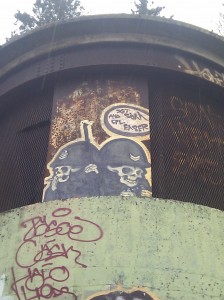Youths in underprivileged areas are able to attain a certain feeling of control over the space they live in through the use of graffiti. These artists use aliases on their wall paintings to identify themselves as the artist. Being recognized as an artist earns them a local reputation similar to the reputation achieved by members of local gangs. Graffiti artists are thus able to achieve local fame in spite of the socioeconomic disadvantage of their neighbourhoods.
David Ley and Roman Cybriwsky argue that tagging is a way to garner a community status and fame in underprivileged communities.(Ley and Cybriwsky, 1974:493) The authors quote a teenager who acknowledges taking up graffiti as a way to avoid gang life. (Ley and Cybriwsky, 1974:495) Graffiti is an economic and political expression and even if the public’s reaction is negative, a substantial number of people identify the graffiti with the artist. This can produce feelings of success which are impossible to obtain elsewhere because of the economic and gang problems which plague their communities. The authors contend that graffiti allows people who do not have access to institutionalized outlets for their art, to express their creativity and claim some control over the space they inhabit. (Ley and Cybriwsky, 1974:494-495)
Young people in disadvantaged areas, whose reputations are advanced by graffiti, become important personalities in their local communities. This reputation leads to an improvement in the perception of their own self-worth thereby reducing or even eliminating the attraction of gang life and violence.
Patrick Armstrong
Works Cited:
Ley, David and Cybriwsky, Roman
1974 Urban Graffiti As Territorial Markers. Annals of the Association of American Geographers 64(4): 491- 505

